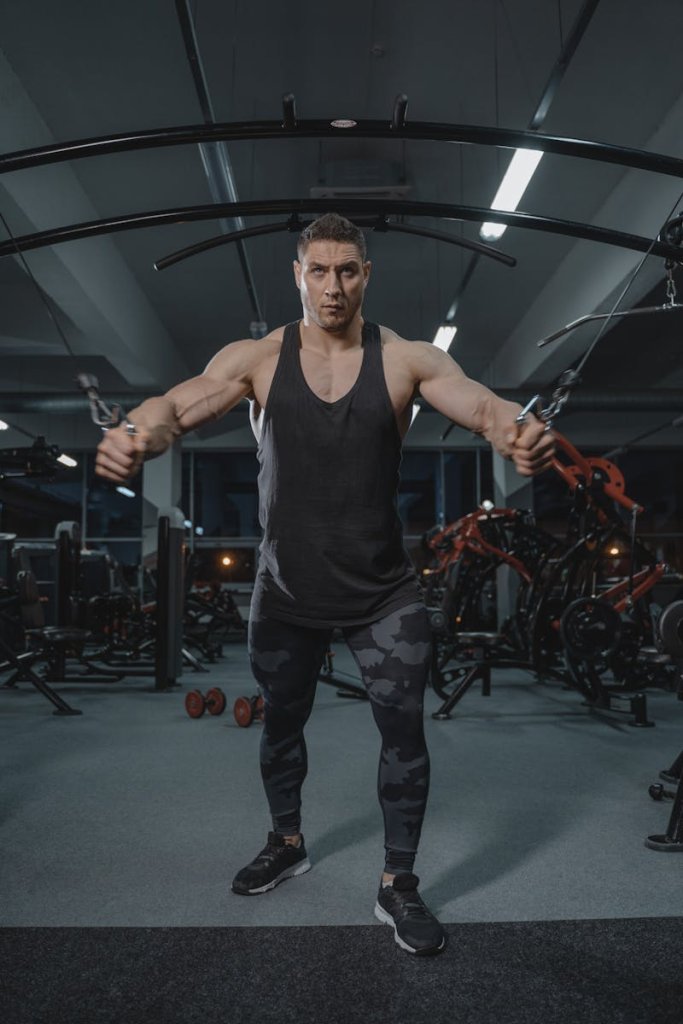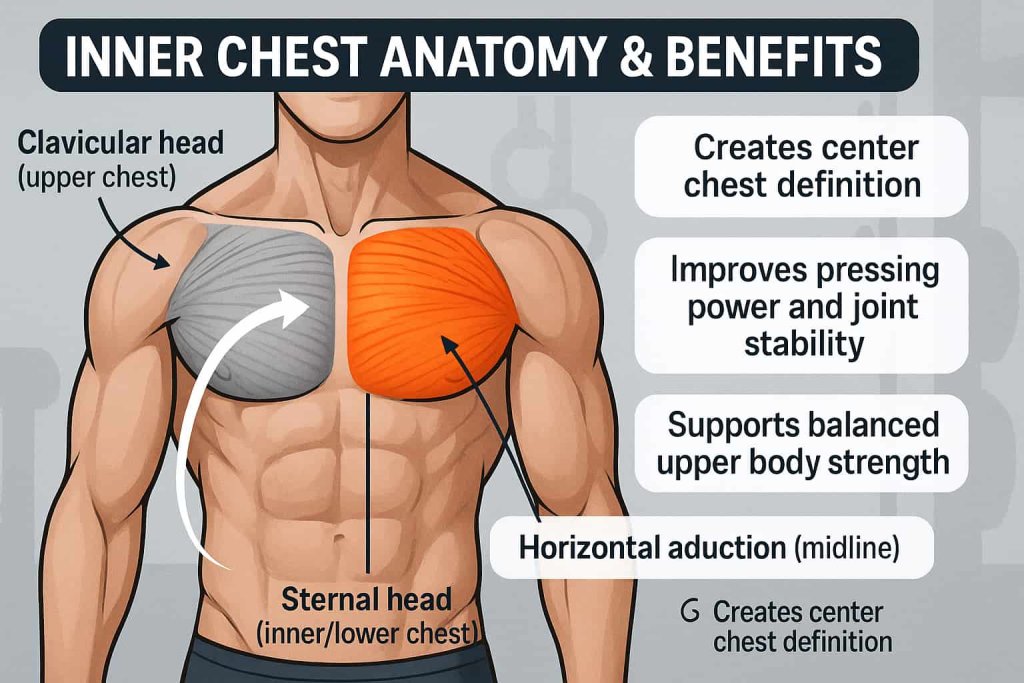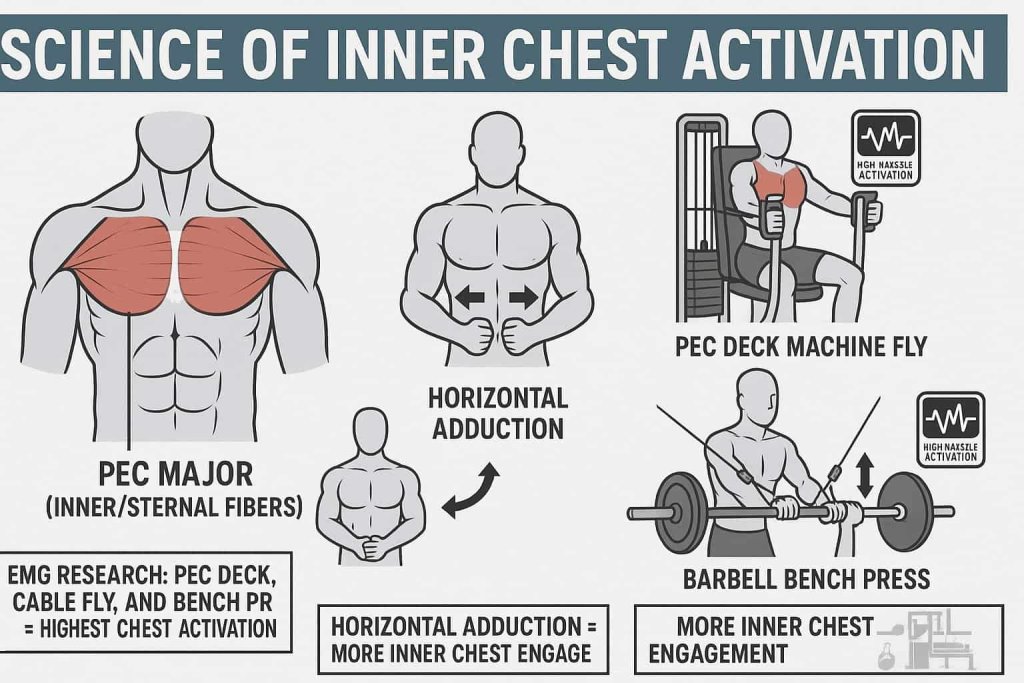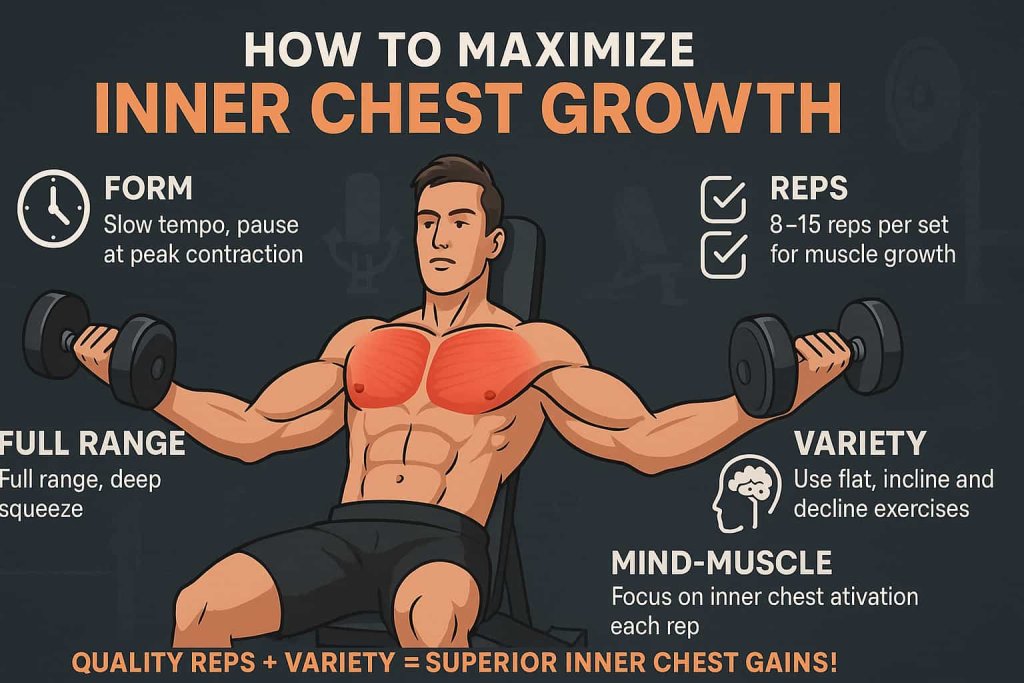The best way to target your inner chest is by focusing on exercises that maximize horizontal adduction and chest muscle activation—these methods are science-backed and used by expert trainers. You can’t fully “isolate” the inner chest, but you can emphasize the sternal fibers of your pectoralis major by using specific movement angles and squeeze techniques. Inner chest development is essential for a fuller, more balanced chest, better aesthetics, and improved upper body strength.

In this article, you’ll discover the 12 best exercises for your inner chest, learn the science behind muscle activation, get a detailed workout routine, and find actionable tips and real-world examples—all supported by the latest research and official resources.
What Is the Inner Chest? (And Why Target It?)
Understanding Inner Chest Anatomy
The “inner chest” isn’t a separate muscle, but refers to the sternal fibers of the pectoralis major that run along your breastbone (sternum).

- Pectoralis major has two heads: clavicular (upper) and sternal (lower/inner).
- The sternal fibers are most engaged when your upper arms move across your body’s midline (horizontal adduction).
Why target this area?
- Many lifters have underdeveloped inner pecs due to focusing only on heavy presses.
- Developing the inner chest improves overall chest fullness, creates a visible “line” in the center of your chest, and supports balanced strength.
- It also aids pressing power, stability, and joint health.
The Science Behind Inner Chest Training

Muscle Activation: What the Research Shows
- EMG (electromyography) studies are the gold standard for measuring muscle activation.
- According to ACE-sponsored research, the pec deck machine fly, cable crossover, and bench press are among the most effective chest moves for muscle activation (ACE Fitness, 2021).
- Exercises involving horizontal adduction—where you bring your arms together in front of your body—show higher inner chest engagement.
Recent updates:
- A 2024 review confirms that adjusting your exercise angle and range of motion can shift emphasis to the inner chest, especially with fly and squeeze variations.
- Moderate loads and high-quality contractions, not maximum weight, are most effective for targeting the inner pecs.
Key Principles for Effective Inner Chest Workouts
How to Maximize Inner Chest Growth

- Focus on form: Use a slow tempo and pause at the peak contraction to fully engage the inner fibers.
- Train through a full range of motion: Don’t cut reps short; get a full stretch and bring hands together or even cross them for a deeper squeeze.
- Use moderate to high reps: 8–15 reps per set are optimal for hypertrophy (muscle growth).
- Include exercise variety: Mix presses, flyes, and cable moves from flat, incline, and decline angles.
- Train with intent: Mentally focus on the inner chest during each rep (mind-muscle connection).
Expert tip: End your workout with an isolation move like cable flyes or Svend press for a strong finishing pump.
The 12 Best Inner Chest Exercises (Trainer Approved & Science Backed)
If you want to carve out a well-defined inner chest, you need the right exercises and proper technique. Below you’ll find the best moves for inner pec growth—each explained in detail, with science, form tips, and practical usage. Let’s get straight to it!
1. Pec Deck Machine Fly
How to Do It:
- Sit with your back firmly against the pad and feet flat.
- Adjust the arms so your elbows are at chest height, arms slightly bent.
- Grip the handles, keep wrists neutral.
- Exhale and slowly bring your arms together in front of you, focusing on squeezing your chest.
- Hold the contraction for 1–2 seconds, then return to the start with control.
Trainer Tip:
Move slowly, especially during the squeezing phase. Holding the peak contraction maximizes inner chest engagement.
Why It Works:
The pec deck is consistently ranked among the top chest exercises for sternal (inner) pec activation by EMG studies (ACE Fitness, 2021). It’s also joint-friendly and excellent for building the mind-muscle connection.
Real-World Example:
Powerlifters use pec deck flyes before pressing to pre-fatigue the chest, while bodybuilders finish workouts with them to sharpen pec definition.
2. High-to-Low Cable Fly
How to Do It:
- Set both cables above your shoulders.
- Step into the center, stagger your feet for stability.
- With elbows slightly bent, pull both cables down and in, bringing hands to meet at hip level.
- Focus on squeezing your pecs at the bottom.
Trainer Tip:
Cross your wrists at the bottom for an extra squeeze—this increases inner chest fiber recruitment.
Why It Works:
Cables provide constant resistance, increasing time under tension—critical for inner chest growth. The high-to-low angle also emphasizes the lower and inner pecs.
Best For:
Adding variety and peak contraction to your chest routine.
3. Svend Press
How to Do It:
- Hold two small weight plates or a light medicine ball together in front of your chest.
- Stand tall, elbows out, press the plates together hard.
- Slowly extend your arms out in front, maintaining the pressure.
- Pause, then bring the plates back to your chest, still pressing together.
Trainer Tip:
Use light weight; the squeeze, not the load, is what matters here.
Why It Works:
Pressing the plates together creates intense inward force, directly targeting the sternal fibers. It’s perfect for home workouts or as a “pump” exercise in the gym.
Real-World Use:
Bodybuilders often use the Svend press to finish chest sessions, boosting mind-muscle connection.
4. Close-Grip Bench Press
How to Do It:
- Lie flat on a bench, grip the barbell just inside shoulder width.
- Lower the bar to your lower/mid chest, keeping elbows tucked.
- Press up, focusing on pushing your hands toward each other (imagine “bending the bar”).
- Do not flare elbows out.
Trainer Tip:
Avoid going too narrow, which can stress your wrists and elbows—just inside shoulder width is safest.
Why It Works:
Narrower grip shifts the load toward the inner chest and triceps, which EMG studies confirm boosts sternal pec activation.
Pro Example:
NFL combine athletes use close-grip presses to develop pressing strength and dense inner chest muscles.
5. Incline Dumbbell Fly
How to Do It:
- Set a bench to a 30–45° incline.
- Grab a dumbbell in each hand, start above chest, palms facing each other.
- Lower arms wide with elbows slightly bent, feeling the stretch in your chest.
- Squeeze dumbbells together at the top and pause.
Trainer Tip:
Don’t over-stretch at the bottom—stop when you feel a good stretch, not shoulder discomfort.
Why It Works:
This move targets both the upper and inner pecs, with a great range of motion for deep contraction.
Practical Use:
Great for building chest fullness and balance.
6. Single-Arm Cable Crossover
How to Do It:
- Set a cable slightly above chest height.
- Stand sideways, grasp the handle, and pull it across your body until your hand crosses your midline.
- Rotate your torso slightly at the end for max squeeze.
Trainer Tip:
Go lighter and focus on full, controlled range and maximal contraction.
Why It Works:
Unilateral training lets you address muscle imbalances, and the crossing motion ensures full sternal activation.
Best For:
Fixing symmetry issues and maximizing mind-muscle connection.
7. Hex Press (Dumbbell Plate Press)
How to Do It:
- Lie flat on a bench, press two dumbbells together (heads touching).
- Lower them to your chest, maintaining inward pressure.
- Press up, keeping the dumbbells pressed together throughout.
Trainer Tip:
Form and constant pressure are more important than heavy weight.
Why It Works:
Inward force lights up the inner pecs. This is a favorite of physique competitors seeking that “pec line.”
8. Flat Dumbbell Fly
How to Do It:
- Lie on a flat bench, arms extended over chest with a slight bend at the elbows.
- Lower arms out to your sides, feeling a deep stretch in your pecs.
- Bring the weights together over your chest, squeezing at the top.
Trainer Tip:
Avoid lowering weights too far—shoulders should feel safe, not strained.
Why It Works:
A classic for stretching and contracting the chest, with bonus activation for inner pecs when you focus on the squeeze.
Variation:
Try cables or bands for constant resistance.
9. Deficit Push-Up
How to Do It:
- Place hands on two low platforms, dumbbells, or weight plates.
- Lower chest below hand level, pause, then push up explosively.
- Keep elbows at about 45° to your body.
Trainer Tip:
Add a pause at the bottom for more activation.
Why It Works:
The extra range of motion means deeper stretch and more inner pec recruitment compared to floor push-ups.
Best For:
Home or bodyweight routines—advanced lifters can add weight.
10. Low-to-High Cable Fly
How to Do It:
- Set cables low to the ground.
- Grab handles and stand in the middle, step forward.
- With arms slightly bent, bring hands upward and together at upper chest height.
- Cross hands slightly at the top.
Trainer Tip:
Pause at the top for a strong inner chest contraction.
Why It Works:
This upward motion emphasizes the lower and inner pecs, helping sculpt the lower chest and correct sagging.
11. Standing Plate Squeeze Press
How to Do It:
- Stand tall, hold a single plate between your palms at chest height.
- Press your hands together and slowly extend your arms forward, keeping pressure on the plate.
- Bring plate back in and repeat, always maintaining pressure.
Trainer Tip:
Keep tension on the plate at all times—don’t relax between reps.
Why It Works:
Constant inward pressure means more time under tension, which research shows is key for muscle growth.
Great For:
Quick chest finishers or home training.
12. Decline Dumbbell Press (Squeeze Rep)
How to Do It:
- Lie on a decline bench, hold dumbbells over chest.
- As you press up, keep dumbbells pressed together.
- Pause and squeeze at the top, focusing on inner chest contraction.
Trainer Tip:
Go moderate in weight and focus on the squeeze—avoid locking out elbows at the top.
Why It Works:
Decline angle targets lower and inner chest. The “squeeze rep” style increases fiber recruitment, giving your chest routine a fresh stimulus.
Sample Inner Chest Workout Routine
Perform this routine 1–2x per week for balanced chest development:
| Exercise | Sets x Reps |
|---|---|
| Pec Deck Machine Fly | 3 x 12–15 |
| High-to-Low Cable Fly | 3 x 10–15 |
| Close-Grip Bench Press | 3 x 8–12 |
| Hex Press | 2 x 12–15 |
| Deficit Push-Up | 2 x 10–15 |
- Rest 45–60 seconds between sets.
- Progress by increasing reps, sets, or slow tempo.
- For advanced lifters: add one drop set or “rest-pause” set for the final exercise.
Pro Tip: Include at least one fly movement and one press in every chest session for optimal inner chest growth.
Frequently Asked Questions (FAQs)
Can you really isolate the inner chest?
A: No, but you can emphasize it using the exercises above. The chest works as one muscle, but angle, intent, and squeeze can shift more tension to the inner fibers (BarBend, 2024).
How many times should I train chest per week?
A: 2–3 times per week is best for most people, with 10–20 total sets for the chest split across workouts.
Do I need special equipment?
A: Cables and machines are best, but you can still train the inner chest at home with dumbbells, plates, or even bodyweight exercises like push-ups.
What’s the best rep range for inner chest growth?
A: 8–15 reps is ideal for hypertrophy. Go higher (15–20) on isolation/squeeze moves at the end of workouts.
How long does it take to see results?
A: With consistent training and good nutrition, visible changes can appear in 6–8 weeks for most lifters.
Should I use heavy or light weights?
A: Use moderate weights that allow perfect form and a strong squeeze—avoid ego lifting, especially on fly and squeeze exercises.
Trainer Tips & Real-World Insights
- Warm up shoulders and chest before heavy sets to prevent injuries.
- Keep your elbows slightly bent during flyes to protect your joints.
- Use mirrors or film yourself to ensure perfect form—small adjustments can make a big difference in activation.
- Switch up exercise order and angles every 4–6 weeks to prevent plateaus.
- If you have shoulder issues, prioritize machine and cable moves for safety.
Example: A bodybuilder prepping for competition will often add cable crossovers or plate squeeze presses at the end of every chest workout to maximize inner pec definition.
Conclusion
Building your inner chest is not about magic exercises, but about training smart with proper angles, range of motion, and full muscle contraction. By consistently using these 12 science-backed, trainer-approved moves, you’ll develop a fuller, stronger, and more aesthetic chest. Start with the sample routine above, focus on form, and adjust the volume as you progress. Your next level of chest gains starts today!
